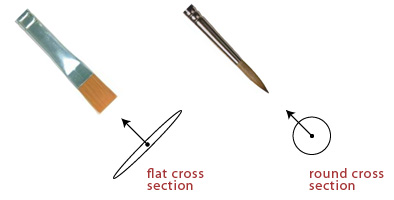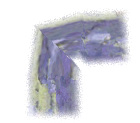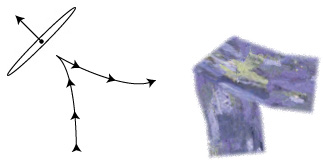Brush Dynamics
Studio580’s brush dynamics are not perfect. So much so, in fact, that they’re listed as problematic in the Problems, Annoyances, and Workarounds Guide and targeted for improvement on the Future Directions page. Nevertheless, Studio580’s brush dynamics are good enough to produce real artwork. Most problems can be mitigated by understanding how Studio580’s brush tool is supposed to work, and by using it intelligently.
Studio580’s brush tool simulates a traditional kind of artist’s brush, called a flat. Flats stroke out pigment by tracing a flat, elliptical cross section across the surface of a canvas. This is in contrast to other kinds of brushes, like rounds and filberts, whose cross sections are more fully rounded. The difference in cross section appearance between flats and more rounded brushes is illustrated in the figure below:

Furthermore, Studio580 uses a straightforward brush dynamics implementation that does not perform any smoothing of the captured mouse trajectory. As a consequence of the decision to simulate flats and to use a straightforward dynamics implementation, Studio580 brushes have some idiosyncrasies:
Brushes don’t turn on a dime—much like real flats, Studio580 brushes do not make tight turns well. Specifically, turning too tightly during a stroke can cause an unsightly kink, as shown below.

Very tight turns are interpreted as reversals of brush direction—if you make a very tight turn (> 88 degrees) in your stroke, Studio580 will interpret it as a reversal of brush direction, in which the sweeping edge of the brush instantaneously changes. The associated visual effect is the placement of a flat end cap at the point where you made your turn. This behavior simulates the way many real artsits handle flats, and is illustrated below.

With these idiosyncrasies in mind, I offer these recommendations on the use of the brush tool:
Don’t turn the brush too quickly—if you need to make rapid changes in direction, make multiple, short, straight strokes that overlay each other, gradually “sketching in” the desired direction change over the course of several strokes rather than rendering it in a single stroke. This is analogous to how most real artists use flats.
Be smooth—long strokes that curve smoothly deliver excellent results.
Use Undo—don’t accept kinky strokes. If you generate a stroke with kinks, undo it and paint it again.
PAGE 1 | NEXT >